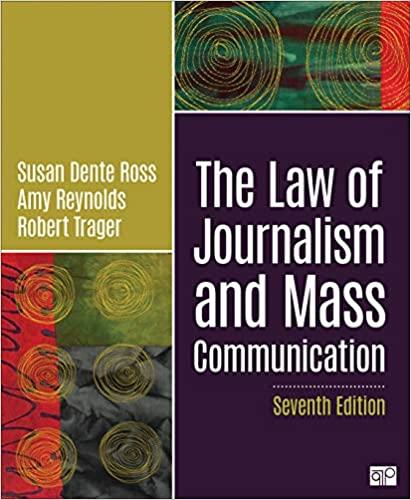Question
1. Damages intended to make a plaintiff whole, and include subcategories of general damages and special damages, are known as a. compensatory b. nominal c.
1. Damages intended to make a plaintiff whole, and include subcategories of general damages and special damages, are known as
a. compensatory
b. nominal
c. punitive
d. equitable
2. When a person makes a false statement of fact about another person to a third party, for the purpose of harming the individual's reputation, what potential tort has been committed?
a. assault
b. intentional infliction of emotional distress
c. battery
d. defamation
3. If a public figure wants to sue a newspaper for writing a libelous article, what additional element must they prove?
a. intent
b. falsity
c. actual malice
d. harm to reputation
4. Which of the following is not an element of a negligence case?
a. duty
b. breach
c. intent
d. damages
5. Negligence looks to what standard when determining if a person is liable?
a. a subjective person standard
b. what the defendant actually believed
c. the defendant's intent
d. a reasonable person standard
6. The concept of actual cause looks to see if a plaintiff's injuries, as a result of the defendant's conduct, are
a. the proximate cause
b. foreseeable
c. the intended consequence
d. the "but for" cause
7. A defense in tort law that says if the plaintiff was also negligent in causing their injury, they cannot recover anything from the defendant.
a. assumption of the risk
b. pure comparative negligence
c. contributory negligence
d. modified comparative negligence
8. Strict liability can be imposed in what situation?
a. keeping dangerous animals
b. conducting abnormally dangerous activities
c. product liability cases for unreasonably dangerous products
d. all of the above
9. The process of determining if a particular law is constitutional is known as
a. judicial review
b. separation of powers
c. supremacy
d. checks and balances
10. When a federal law takes precedence over a competing state law in an area that Congress was to regulate exclusively it is known as
a. preemption
b. police powers
c. checks and balances
d. separation of powers
Step by Step Solution
There are 3 Steps involved in it
Step: 1

Get Instant Access to Expert-Tailored Solutions
See step-by-step solutions with expert insights and AI powered tools for academic success
Step: 2

Step: 3

Ace Your Homework with AI
Get the answers you need in no time with our AI-driven, step-by-step assistance
Get Started


